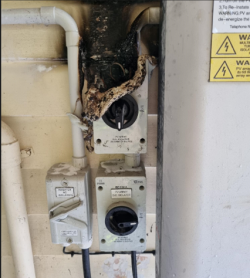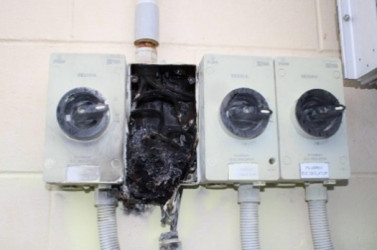Electron Issue 119
Keeping you up to date with the latest regulatory changes, exam reports, technical issues, consultation results and other issues affecting electrical workers – published March 2023.
Presiding Member's update

Kia ora
With the significant adverse weather events over the past couple of months, the electricity network has suffered some major damage. With some properties still without a grid connected power supply, the use of generators has increased.
It is worth noting that Energy Safety has issued a notice around the safe use and connection of generators. This is available to view on their website:
Using portable generators after Cyclone Gabrielle(external link) — WorkSafe
There is also AS/NZS3010 that can assist with the connection of generators to properties.
It is also timely to remember that, whilst emergency work has and will be required, there is still no such thing as temporary work and any PEW must have a CoC or ESC issued.
Please ensure, if you are required to do emergency work, that you take time to consider what you are going to do as it may differ from the norm. You may find yourselves under pressure to take shortcuts but please ensure you leave the installations electrically safe.
Russell Keys
Presiding Member
Registrar update

Kia ora koutou
Thank you for reading another edition of the Electron newsletter.
My thoughts are with those impacted by the recent weather events, especially those who have lost their homes, businesses, and belongings. In this newsletter, Energy Safety has provided some helpful information regarding electrical safety in an emergency. Following the recent events, it is worth familiarising yourself with this information.
I also want to acknowledge Susan Allan’s retirement. Susan retired in March after 16 years of service, with most of that time spent supporting the EWRB. During her time with us, Susan had a big hand in many current electrical workers obtaining their Registration. Susan was an exemplar of Public Service values, and the mahi she undertook in her role was always done with the people of Aotearoa at the front of her mind.
Take care, work safely, and I hope you enjoy reading this edition of Electron.
If you have any comments or suggestions for future Electron editions, please let me know by emailing Registrations@ewrb.govt.nz
Duncan Connor
Registrar of Electrical Workers
Standard of the month
AS/NZS 3017:2022 Electrical Installations – Verification by inspection and testing
Introduction
AS/NZS 3017:2022 sets out the common test and inspection methods required to verify that a low voltage MEN electrical installation complies with the fundamental electrical safety requirements. This latest version supersedes the earlier 2007 edition and has been expanded and enhanced with additional features. These additional features incorporate more detailed guidance on testing procedures with accompanying colour highlighted illustrations increasing clarity and ease of use.
The testing and inspection methods in this standard provide a safe and practicable means to satisfy the fundamental safety testing and inspection requirements for installations before they are put into service.
Features of this new standard
- Colour highlighted diagrams illustrating test procedures amended for clarity.
- Tests for polarity, phase rotation and correct circuit connections combined, because they are interrelated.
- Tests of the integrity of incoming neutral.
- Figures amended to reflect increasing use of residual current devices (RCDs).
- Testing for correct installation and functioning of RCDs.
- Additional tests for measurement of the resistance of the earth electrode and measurement of touch voltage.
- Increased guidance on selection and checking of test equipment.
This is one of the over 95 Standards that are available for all licenced electrical workers to access from the EWRB online portal.
Electrical Safety during an emergency event
On the 14 February 2023, the New Zealand government declared a state of disaster following an unprecedented weather event that had major and devastating impacts across much of the North Island. This declaration applied to 6 regions in the middle to upper North Island and represents only the third occasion in New Zealand history that a National State of Emergency has been declared.
The Board acknowledges the significant extent of human tragedy, suffering and loss that continues to unfold while recognizing the vital contribution electrical workers are making to public health and safety through the restoration of essential electricity services to affected homes and business.
Much of this work has been carried out under very demanding circumstances. Although network supplies have been progressively restored, some installations will continue to be reliant on emergency electricity supplies from generators as this work is fully completed.
While appreciating the challenges, urgency, and importance of restoring vital electricity supplies, the Board reminds all parties that it is essential all electrical work should only be carried out by a competent person who is authorised to do that type of work. In addition, electrical safety is paramount, and should never be compromised either during that work or when it has been completed.
The Board would also like to take the opportunity to highlight the following industry guidance from WorkSafe Energy Safety. This sets out high-level principles for connecting a generator to the wiring of an installation when the network power has been disrupted as result of an emergency.
Using generators to supply electricity to an installation during an emergency
Recent severe weather events created demand for the use of generators to provide electricity to installations that in normal circumstances are supplied from the grid.
Many New Zealand installations are not designed or constructed to be supplied with electricity from an alternative supply, such as a generator, increasing the safety risks when alterative supply connections are installed. It’s important that the electrical worker installing alternative connections understands and applies electrical safety principles.
To help establish a safe alternative supply of electricity to these installations, WorkSafe New Zealand Energy Safety has published a technical bulletin. This applies high-level safety principles for connecting a generator to the wiring of an installation under emergency circumstances.
Connecting a generator to the wiring of a house or building following an emergency(external link) — WorkSafe
Guidance for businesses and kaimahi after Cyclone Gabrielle(external link) — WorkSafe
Applying safety principles for the connection of alternative power supplies during emergencies
Key factors to keep workers and others safe.
Testing for safety
Start the work with testing and make sure there is no grid supplied electricity to the installation.
Ensure all completed work is safe to use and that all required protection is in place and will operate safely as intended.
Before the network power is restored, make sure:
- the temporary conductors have been removed
- all multiple earth neutral links are restored
- any damaged fittings remain isolated
- the installation has been assessed to section 5 of AS/NZS 3019
- the installation has been tested in accordance with section 8 of AS/NZS 3000.
Disconnection and isolation
- Ensure all incoming supply conductors are disconnected and insulated.
- Remember that the neutral is a considered a live conductor and has the potential to inadvertently become live during work on the supply network.
- Therefore, it is important to ensure the neutral conductor is also disconnected and insulated.
Bonding system
- Ensure all electrical equipment with exposed conductive parts are securely bonded.
- This will ensure equal potential earthing is provided across exposed conductive parts maintaining safety in the event of an earth fault occurring.
- The earthing system of the installation (main earthing bar) and the generator metalwork must be bonded to each other.
- Residual current devices (RCD’s) must be used to disconnect the generated supply during an earth fault condition; therefore the bonding system must be connected to the installations earthing system.
- Remember that older installations may still have, the main earthing conductor connected to the neutral bar. This will need to be rearranged to ensure the generator supply RCD will operate correctly.
Removing the connection between the earth and neutral (removable link)
- The neutral – earth link (also known as the multiple earth neutral (MEN) link) located at the main switchboard (and any distribution Boards) will need to be removed.
- When an MEN link is not removed within the installation it will result in the tripping of the generator RCD.
- Removal of the MEN link will not affect the overall safety of the installation because the installation is being powered from an alternative generator supply, not an MEN system of supply.
- Ensure where an MEN link has been removed a warning label is affixed to the main switchboard indicating all of the alterations that have been carried out within the installation.
Earthing of the generator supply neutral
- The generator should have a link between its earth bonding and one of its output poles to create a neutral pole within the generator.
- If the generator does not have a link between its earth bonding and one of its output poles then a link will need to be installed to create a neutral pole.
RCD protection against earth faults
- All generator supplies must have RCD protection on their output to ensure the supply is safely disconnected in the event of an earth fault.
- For those generators without integral RCD protection, it is important that a 2 pole RCD is installed as close as possible to the generator output.
- RCD protection is critical to prevent severe electric shocks. This is also needed because the generator is unlikely to deliver sufficient fault current to operate the installations protective devices.
Centre tapped generators
- A centre tapped generator with two active outputs and an earthed centre point must have its supply protected by a 2 pole RCD installed as close as possible to the generator output.
- Do not earth any of the active outputs and only bond to earth at the centre tap termination.
- The output poles can then be connected to the neutral bar and phase termination at the main switchboard within the installation.
- In this arrangement the neutral bar becomes live and therefore must be protected from contact.
- Be aware this arrangement will result with both actives having a potential to earth being present within the installation.
DC (direct current) isolators for PV (photovoltaic) systems
The Board have been made aware of a recent event which is still under investigation by WorkSafe Energy Safety where a roof top mounted DC isolator was identified as the probable origin of a fire in a PV system.
Energy Safety have advised that while the specific casual factors for the failure of the DC isolator are still being analysed, it presents a timely reminder that New Zealand does not require DC isolators for PV arrays to be mounted on the roof where they are more exposed to the elements and have greater dangers of failure due to water ingress.
This issue was identified in an investigative report from the Australian Clean Energy Regulator PV System Residual Systemic Electrical Safety Risks where it was found that:
- DC roof mounted isolators created greater risks of water ingress and were found to be the most common cause of unsafe/failed PV systems and a known cause of fires.
WorkSafe Energy Safety has provided more information on this topic and a good practice installation check list for DC isolators below.
Installation of international protection (IP) rated enclosures for DC isolators used in PV systems
Location and environmental factors
Roof top mounted isolators are more exposed to environmental factors such as ultraviolet radiation, wind, rain and therefore subject to an increasing risk of damage and deterioration. These risks combined with substandard installation of international protection (IP) rated enclosures increase the likelihood of water ingress.
DC isolators for PV systems are not required to be mounted on the rooftop next to the PV arrays and may be installed in other more suitable locations. It is recommended that the following factors are considered when determining the location of DC isolators in exterior locations.
- Sheltered from direct rain (under structural overhangs, eaves or similar)
- Sheltered from direct prevailing direction of the sun (as much as possible)
- Accessibility while still providing a safe location
Correct installation methods
To maintain the IP rating integrity of an enclosure and prevent the ingress of water, it is important that the installation is carried out in strict accordance with manufacturer’s instructions.
Substandard installation practices will allow water/moisture to collect inside the isolator enclosure. This situation can cause corrosion, damage to terminals, contacts and switching mechanisms all of which may create high resistance points of contact. When current is being carried across these areas of high resistance 'hot spots' may occur which can eventually lead to fitting failure and fire events.
Good practice installation guide checklist for IP rated enclosures
Note: The following information is only intended to be a general guide. It is important the appropriate manufacturer’s instructions and recommendations for the specific product being installed are used.
- The fixing or securing (screws/fasteners) through the base of the enclosure may be located at the correct locations and sealed with the appropriate caps/sealant (do not drill holes in alternative locations unless the manufacturer has a permitted system to allow this).
- Use the correct conduits fittings, ensure they are glued or sealed appropriately.
- If using cable compression glands, ensure they are suitable and have the correct IP rating.
- Ensure caps for unused entry points on the base of the enclosure are correctly installed.
- Only use the manufactured entry and exist points to the enclosure for conduit or cable gland entries (do not drill holes in alternative locations unless the manufacturer has a permitted system to allow this).
- Use the manufacturers recommended adhesives or sealants as directed.
- Correctly tension screws which secure the isolator face plate to the base.
- Over tightening can lead to damage.
- Under tensioning can allow moisture entry through the seal resulting from expansion or contraction caused by natural heating and cooling effects.
Selection and termination of DC isolators
To further protect the DC isolator against risks of failure and potential fire it is important to consider the following:
- The correctly rated DC isolator for both current and voltage as specified in standard AS/NZS 5033 is selected and fitted.
- The DC isolator terminal screws are correctly tensioned to provide secure and reliable connections. This may be achieved by using a torque setting screwdriver to make sure the screws are tightened to a predetermined value, as recommended by the manufacturer of the product.
Images showing 2 examples of DC isolators that have failed and caught fire


Assistance with sitting exams
Did you know that if you have sat one of the required exams to become a registered Electrical Worker but did not pass the exam, then you may be eligible to apply to Aspeq for one of 2 types of assistance?
Depending on the assistance your need, you can apply for either:
- extra time to complete the exam
- a reader to read the exam questions (for example, if you have difficulties reading or English is your second language).
Applications for extra time and readers do cost on top of the exam fee. We recommend you discuss extra assistance with your training provider before you make a decision to apply for assistance.
If you have already sat and failed an exam in relation to your Electrical Workers registration, and you believe that you need to apply for extra assistance to sit the same exam again, you must:
1. Apply in writing using the extra assistance request form:
Extra assistance request application form(external link) — Aspeq
2. Email the filled in form to info@aspeq.com
Training providers
Training providers can make bulk bookings using the Aspeq booking system’s organisation portal.
Disciplinary hearings
The Board dealt with 9 disciplinary matters in March. Three of them were not upheld.
When complaints come before the Board, the Investigator has to prove their case. To do that, the Investigator must present evidence to try and establish that, on the balance of probabilities, a disciplinary offence has been committed. If they are not able to, then the Board will find that the disciplinary offence has not been committed.


